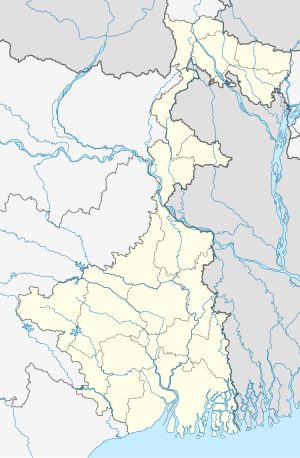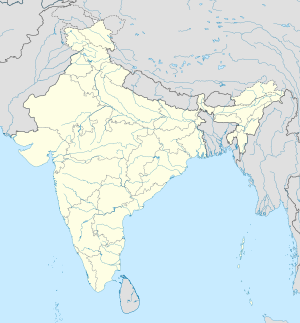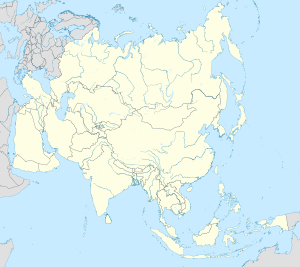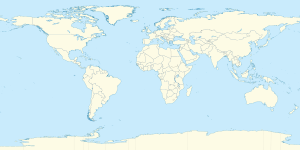Diamond Harbour
Diamond Harbour | |
|---|---|
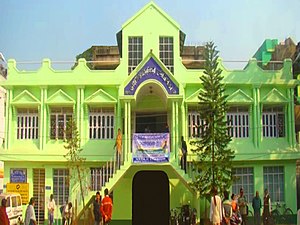 Diamond Harbour Municipality | |
 Interactive map outlining Diamond Harbour | |
| Coordinates: 22°11′34″N 88°11′22″E / 22.1926886°N 88.1894879°E | |
| Country | |
| State | |
| Division | Presidency |
| District | South 24 Parganas |
| Government | |
| • Type | Municipality |
| • Body | Diamond Harbour Municipality |
| Area | |
• Total | 10.36 km2 (4.00 sq mi) |
| Elevation | 7 m (23 ft) |
| Population (2011) | |
• Total | 41,802 |
| • Density | 4,000/km2 (10,000/sq mi) |
| Demographics | |
| • Literacy | 85.93 per cent |
| • Sex ratio | 986 ♂/♀ |
| Languages | |
| • Official | Bengali[1][2] |
| • Additional official | English[1] |
| Time zone | UTC+5:30 (IST) |
| PIN | 743331 |
| Telephone code | +91 3174 |
| Vehicle registration | WB-19, WB-20, WB-95, WB-96, WB-97, WB-98 |
| Lok Sabha constituency | Diamond Harbour |
| Vidhan Sabha constituency | Diamond Harbour |
| Website | diamondharbourmunicipality |
Diamond Harbour (Bengali: [ˈɖai̯mənɖ ˈɦaɾbaɾ] ⓘ) is a city and a municipality of the South 24 Parganas district in the Indian state of West Bengal. It is the headquarters of the Diamond Harbour subdivision.
History
[edit]
Diamond Harbour was originally known as Hajipur, as it was situated on the banks of the Hajipur creek. The name Diamond Harbour was applied by the British, who used it for both river and sea shipping.[3][4] The area was known since 16th and 17th-century Portuguese river pirates, (harmad).[5] There was a fort named Chingrikhali Kella, reportedly built by Portuguese pirates during 1600s, presently dilapidated.[6]
Geography
[edit]
5miles
Bagaria
Anantapathpur
M: municipal city/ town, CT: census town, R: rural/ urban centre, N: neighbourhood, H: historical place/ religious centre
Owing to space constraints in the small map, the actual locations in a larger map may vary slightly
Area overview
[edit]Diamond Harbour subdivision is a rural subdivision with patches of urbanisation. Only 14.61% of the population lives in the urban areas and an overwhelming 85.39% lives in the rural areas. In the western portion of the subdivision (shown in the map alongside) there are 11 census towns. The entire district is situated in the Ganges Delta and the western part, located on the east bank of the Hooghly River, is covered by the Kulpi Diamond Harbour Plain, which is 5–6 metres above sea level. Archaeological excavations at Deulpota and Harinarayanpur, on the bank of the Hooghly River indicate the existence of human habitation more than 2,000 years ago.[7][8][9]
Note: The map alongside presents some of the notable locations in the subdivision. All places marked in the map are linked in the larger full screen map.
Location
[edit]Diamond Harbour is located at 22°11′34″N 88°11′22″E / 22.1926886°N 88.1894879°E. It has an average elevation of 7 metres (23 ft).[10]
Climate
[edit]Köppen-Geiger climate classification system classifies its climate as tropical wet and dry (Aw).
The overall climate of Diamond harbour is warm and humid. The summer temperature often crosses 35 °C when it drops 15 °C. The highest temperature ever was 43.0 °C, recorded on 21 May 2002. The lowest temperature dropped was 8.2 °C, on 13 January 2003. The annual average rainfall is 1600 mm. The air is moderately humid, around 76%.
| Climate data for Diamond Harbour (1991–2020, extremes 1978–2020) | |||||||||||||
|---|---|---|---|---|---|---|---|---|---|---|---|---|---|
| Month | Jan | Feb | Mar | Apr | May | Jun | Jul | Aug | Sep | Oct | Nov | Dec | Year |
| Record high °C (°F) | 33.2 (91.8) |
38.0 (100.4) |
40.6 (105.1) |
41.9 (107.4) |
43.0 (109.4) |
40.4 (104.7) |
38.0 (100.4) |
38.5 (101.3) |
37.5 (99.5) |
37.4 (99.3) |
35.6 (96.1) |
32.6 (90.7) |
43.0 (109.4) |
| Mean daily maximum °C (°F) | 25.4 (77.7) |
29.1 (84.4) |
32.7 (90.9) |
34.0 (93.2) |
34.3 (93.7) |
33.5 (92.3) |
32.1 (89.8) |
32.2 (90.0) |
32.4 (90.3) |
32.3 (90.1) |
30.2 (86.4) |
26.8 (80.2) |
31.3 (88.3) |
| Mean daily minimum °C (°F) | 13.9 (57.0) |
17.9 (64.2) |
22.8 (73.0) |
25.8 (78.4) |
26.8 (80.2) |
27.2 (81.0) |
26.8 (80.2) |
26.8 (80.2) |
26.5 (79.7) |
24.6 (76.3) |
19.9 (67.8) |
15.1 (59.2) |
22.8 (73.0) |
| Record low °C (°F) | 6.8 (44.2) |
9.8 (49.6) |
14.1 (57.4) |
18.0 (64.4) |
18.0 (64.4) |
21.4 (70.5) |
23.2 (73.8) |
21.5 (70.7) |
20.4 (68.7) |
18.5 (65.3) |
13.3 (55.9) |
9.7 (49.5) |
6.8 (44.2) |
| Average rainfall mm (inches) | 15.0 (0.59) |
27.8 (1.09) |
28.8 (1.13) |
46.5 (1.83) |
125.1 (4.93) |
258.6 (10.18) |
386.1 (15.20) |
365.1 (14.37) |
300.8 (11.84) |
147.5 (5.81) |
29.4 (1.16) |
8.3 (0.33) |
1,739 (68.46) |
| Average rainy days | 1.1 | 1.3 | 1.7 | 2.9 | 6.1 | 12.2 | 16.7 | 17.0 | 13.2 | 6.1 | 1.6 | 0.5 | 80.4 |
| Average relative humidity (%) (at 17:30 IST) | 69 | 66 | 67 | 77 | 78 | 84 | 86 | 86 | 86 | 81 | 75 | 73 | 77 |
| Source: India Meteorological Department[11][12][13] | |||||||||||||
Demographics
[edit]Population
[edit]| Year | Pop. | ±% |
|---|---|---|
| 1951 | 9,818 | — |
| 1961 | 10,135 | +3.2% |
| 1971 | 13,072 | +29.0% |
| 1981 | 20,259 | +55.0% |
| 1991 | 30,266 | +49.4% |
| 2001 | 37,234 | +23.0% |
| 2011 | 41,802 | +12.3% |
| Source: Census of India[14] | ||
According to the 2011 Census of India, Diamond Harbour had a total population of 41,802, of which 21,050 (51%) were males and 20,752 (49%) were females. It had a population density of 4,035 inhabitants per square kilometre (10,450/sq mi) with a sex ratio of 986 females for every 1000 males. There were 3,688 persons in the age range of 0 to 6 years. The Scheduled Castes numbered 5,221 (12.49%) and the Scheduled Tribes numbered 72 (0.17%). The total number of literate persons was 32,753 (85.93% of the population over 6 years) out of which males numbered 17,193 (89.57% of the male population over 6 years) and females numbered 15,560 (82.25% of the female population over 6 years). Diamond Harbour had a total of 10,048 households as of 2011.[15]
Language
[edit]At the time of the 2011 Census of India, 99.14% of the population spoke Bengali, 0.82% Hindi and 0.03% Urdu as their first language.[16]
Religion
[edit]According to the 2011 Census of India, 85.98% of the population is Hindu, 13.75% Muslim, 0.11% Christian, 0.10% Sikh, 0.01% Buddhist and 0.01% Jain. 0.04% did not state a religion in the census.[17]
Civic administration
[edit]Municipality
[edit]Diamond Harbour Municipality covers an area of 10.36 km2 (4.00 sq mi). It has jurisdiction over the entire city of Diamond Harbour. The municipality was established in 1982. It is divided into 16 administrative wards. According to the 2022 municipal election, it is being controlled by the All India Trinamool Congress.[18][19]
Police stations
[edit]Diamond Harbour police station covers an area of 134 km2 (52 sq mi). It has jurisdiction over parts of the Diamond Harbour Municipality, and the Diamond Harbour I and Diamond Harbour II CD blocks.[20][21]
Diamond Harbour women police station has jurisdiction over parts of the Diamond Harbour Municipality, and the Diamond Harbour I and Diamond Harbour II CD blocks.[22][21]
CD block HQ
[edit]The headquarters of the Diamond Harbour I CD block are located at Diamond Harbour.[23]
Transport
[edit]Diamond Harbour is on the National Highway 12.[24]
Diamond Harbour railway station is on the Sealdah–Diamond Harbour line of the Kolkata Suburban Railway.[24][25]
Commuters
[edit]With the electrification of the railways, suburban traffic has grown tremendously since the 1960s. As of 2005–06, more than 1.7 million (17 lakhs) commuters use the Kolkata Suburban Railway system daily. After the partition of India, refugees from East Pakistan/ Bangladesh had a strong impact on the development of urban areas in the periphery of Kolkata. The new immigrants depended on Kolkata for their livelihood, thus increasing the number of commuters. Eastern Railway runs 1,272 EMU trains daily.[26]
Education
[edit]- Diamond Harbour Government Medical College and Hospital, established in 2019, is a full-fledged tertiary referral government medical college.[27]
- Diamond Harbour Government Polytechnic, established in 2014, offers diploma, undergraduate and postgraduate degree courses in Engineering and Technology and other allied fields.[28]
- Diamond Harbour Women's University, established in 2013, is the first university of the state for women.[29]
- Fakir Chand College, established in 1948, is affiliated with the University of Calcutta. It offers honours courses in Bengali, English, Sanskrit, history, political science, philosophy, economics, geography, education, mathematics and accounting & finance, and general degree courses in arts, science, and accounting & finance.[30]
Healthcare
[edit]Diamond Harbour Subdivisional Hospital, with 250 beds, is the major government medical facility in the Diamond Harbour subdivision.[31]
References
[edit]- ^ a b "Fact and Figures". Wb.gov.in. Retrieved 5 July 2019.
- ^ "52nd Report of the Commissioner for Linguistic Minorities in India" (PDF). Nclm.nic.in. Ministry of Minority Affairs. p. 85. Archived from the original (PDF) on 25 May 2017. Retrieved 5 July 2019.
- ^ The Imperial Gazetteer of India. Vol. IX: Coondapoor to Edwardesabad. Clarendon Press. 1908. p. 340.
- ^ British Cyclopædia of the Arts, Sciences, History, Geography, Literature, Natural History, and Biography. Wm. S. Orr and Company. 1838.
- ^ "Spend a perfect weekend at Diamond Harbour". Get Bengal. Retrieved 1 February 2024.
- ^ Sengupta, Tania Roy. "Diamond Harbour Diaries: The uncomfortable path that took us to Diamond Harbour Fort ruins". Tripoto. Retrieved 1 February 2024.
- ^ "District Statistical Handbook 2014 South Twety-four Parganas". Table 2.1, 2.2, 2.4b. Department of Statistics and Programme Implementation, Government of West Bengal. Retrieved 5 December 2019.
- ^ "Census of India 2011, West Bengal, District Census Handbook, South Twentyfour Parganas, Series – 20, Part XII-A, Village and Town Directory" (PDF). Page 13, Physiography. Directorate of Census Operations, West Bengal. Retrieved 5 December 2019.
- ^ "District Human Development Report: South 24 Parganas". Chapter 9: Sundarbans and the Remote Islanders, p 290-311. Development & Planning Department, Government of West Bengal, 2009. Archived from the original on 5 October 2016. Retrieved 5 December 2019.
- ^ Falling Rain Genomics, Inc - Diamond Harbour
- ^ "Climatological Tables of Observatories in India 1991-2020" (PDF). India Meteorological Department. Retrieved 8 April 2024.
- ^ "Station: Diamond Harbour Climatological Table 1981–2010" (PDF). Climatological Normals 1981–2010. India Meteorological Department. January 2015. pp. 253–254. Archived from the original (PDF) on 5 February 2020. Retrieved 10 January 2021.
- ^ "Extremes of Temperature & Rainfall for Indian Stations (Up to 2012)" (PDF). India Meteorological Department. December 2016. p. M234. Archived from the original (PDF) on 5 February 2020. Retrieved 10 January 2021.
- ^ "Census of India 2011, West Bengal, District Census Handbook, South Twentyfour Parganas, Series – 20, Part XII-A, Village and Town Directory" (PDF). Section II Town Directory, Pages 999-1031 Statement I: Growth History, Pages 999-1006. Directorate of Census Operations, West Bengal. Retrieved 17 October 2019.
- ^ "Census of India 2011, West Bengal, District Census Handbook, South Twentyfour Parganas, Series – 20, Part XII-B, Village and Town Wise Primary Census Abstract" (PDF). Urban PCA-Town wise Primary Census Abstract, Pages 536-583. Directorate of Census Operations, West Bengal. Retrieved 17 October 2019.
- ^ a b "Table C-16 Population by Mother Tongue: West Bengal". www.censusindia.gov.in. Registrar General and Census Commissioner of India.
- ^ a b "Table C-01 Population by Religion: West Bengal". censusindia.gov.in. Registrar General and Census Commissioner of India. 2011.
- ^ "Diamond Harbour Municipality". West Bengal Valuation Board. Government of West Bengal. Retrieved 18 May 2015.
- ^ "Diamond Harbour Municipality". Department of Municipal Affairs. Government of West Bengal. Archived from the original on 21 April 2017. Retrieved 18 May 2015.
- ^ "Diamond Harbour police station". Diamond Harbour police district. West Bengal police. Retrieved 20 October 2019.
- ^ a b "District Statistical Handbook 2014 South 24 Parganas". Table No. 2.1. Department of Statistics and Programme Implementation, Government of West Bengal. Retrieved 20 October 2019.
- ^ "Diamond Harbour Women PS". Diamond Harbour police district. West Bengal police. Retrieved 20 October 2019.
- ^ "BDO Offices under South 24 Parganas District". West Bengal Public Library Network, Government of West Bengal. Archived from the original on 3 October 2018. Retrieved 17 October 2019.
- ^ a b Google maps
- ^ "34814 Sealdah-Diamond Harbour Local". Time Table. India Rail Info. Retrieved 16 December 2019.
- ^ Mondal, Bhaswati. "Commuting and Metropolitan Development of Kolkata". Retrieved 29 December 2019.
- ^ "Diamond Harbour Government Medical College & Hospital". DHGMC. Retrieved 30 October 2019.
- ^ "Diamond Harbour Government Polytechnic". DHGP. Retrieved 30 October 2019.
- ^ "Diamond Harbour Women's University". DHWU. Retrieved 30 October 2019.
- ^ "Fakir Chand College". FCC. Retrieved 30 October 2019.
- ^ "Health & Family Welfare Department" (PDF). Health Statistics - Hospitals. Government of West Bengal. Archived from the original (PDF) on 14 September 2020. Retrieved 17 December 2019.
External links
[edit] Media related to Diamond Harbour at Wikimedia Commons
Media related to Diamond Harbour at Wikimedia Commons Diamond Harbour travel guide from Wikivoyage
Diamond Harbour travel guide from Wikivoyage

